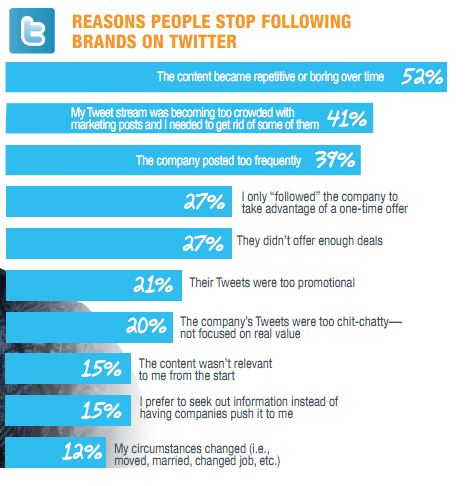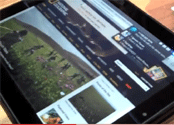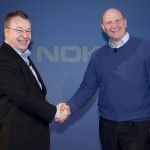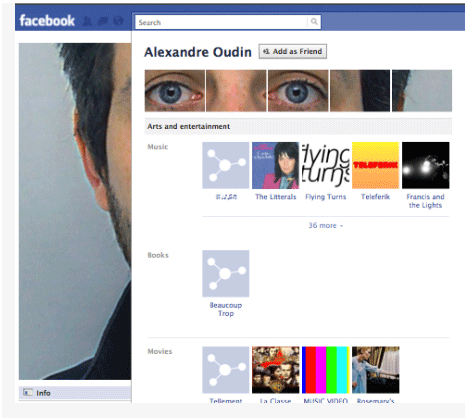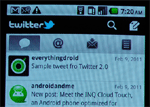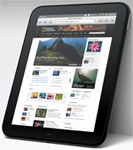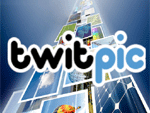[wpsqt name=”TesttoTake” type=”quiz”]
Test To Take
Hands On With New HP TouchPad Tablet Running on WebOS [Video]
Just two days back HP has unveiled its first ever Tablet running on much expected WebOS named “TouchPad”. HP Touch pad, which is loaded with dual core 1.2 Ghz snapdragon processor and 1 GB of RAM, is already started making buzz in the market. At the launch event, company has released an introductory brief video to talk about its features. However, the real potential and smooth drive was virtually unknown due to absence of any hands-on experience over TouchPad – until now.
Recently, Hewlett Packard executives spent a couple of hours gushing over the features of WebOS, as showcased on the new TouchPad tablet. After the WebOS event was over, the company welcomed guests to come and see the devices in action. There was a strict no-touching rule – but thanks to ZDNet who managed to stay close with one of the demonstration and got it captured in their camera which provides an incomprehensive but closer look to new tablet baby of HP.
Though the video was long, it has been edited only to showcased the features of HP TouchPad. Enjoy the video after a break.
httpv://www.youtube.com/watch?v=Jk63WgGP698
Nokia And Microsoft Officially Announce Their Marriage
So the “D” day has finally come and as we had predicted around a month back, Microsoft has managed to pocket Nokia – atleast virtually. Today Nokia has posted letter to its web site from Microsoft CEO Steve Ballmer and its CEO Stephen ELOP outlining the partnership between the two companies. Both the companies are claiming this as a step towards establishment of a “third mobile ecosystem” to challenge Apple and Google dominance in Smartphone market.
“Today Nokia and Microsoft intend to enter into a strategic alliance. Together we will bring consumers a new mobile experience with stellar hardware, innovative software and great services. We will create opportunities beyond anything that currently exists,” says Nokia CEO Stephen Elop.
“In this partnership with Nokia, Microsoft brings its’ Windows Phone software and the brand mobile consumers want like Bing, Office and of course Xbox Live,” says Microsoft CEO Steve Ballmer.
Below is the video in which Stephen Elop and Steve Ballmer are “trying to predict” the blooming future from this engagement:
httpv://www.youtube.com/watch?v=xe3ksR8zgXg
We don’t know, at this stage, how far Industry and market will react to much anticipated tie-up but there are few issues on the tablet which certainly need to be address by Nokia :
- Will Nokia empowered by only Windows Phone7 OS or continue Symbian 3 improvement?
- What will be the faith of MeeGo mobile OS which is under development jointly by Nokia and Intel?
- Transition for Nokia will be time consuming. Already in deep-dive, can Nokia afford to go on back foot during this transition of 1 -2 years?
While we come back to you with new findings and another great analysis on this newly developed situation, we leave with the letter below which came through Nokia as final announcement. I am sure, many of our readers will have their own thoughts and discussion point on this letter once we will get back:
Today in London, our two companies announced plans for a broad strategic partnership that combines the respective strengths of our companies and builds a new global mobile ecosystem. The partnership increases our scale, which will result in significant benefits for consumers, developers, mobile operators and businesses around the world. We both are incredibly excited about the journey we are on together.
While the specific details of the deal are being worked out, here’s a quick summary of what we are working towards:
- Nokia will adopt Windows Phone as its primary smartphone strategy, innovating on top of the platform in areas such as imaging, where Nokia is a market leader.
- Nokia will help drive and define the future of Windows Phone. Nokia will contribute its expertise on hardware design, language support, and help bring Windows Phone to a larger range of price points, market segments and geographies.
- Nokia and Microsoft will closely collaborate on development, joint marketing initiatives and a shared development roadmap to align on the future evolution of mobile products.
- Bing will power Nokia’s search services across Nokia devices and services, giving customers access to Bing’s next generation search capabilities. Microsoft adCenter will provide search advertising services on Nokia’s line of devices and services.
- Nokia Maps will be a core part of Microsoft’s mapping services. For example, Maps would be integrated with Microsoft’s Bing search engine and adCenter advertising platform to form a unique local search and advertising experience.
- Nokia’s extensive operator billing agreements will make it easier for consumers to purchase Nokia Windows Phone services in countries where credit-card use is low.
- Microsoft development tools will be used to create applications to run on Nokia Windows Phones, allowing developers to easily leverage the ecosystem’s global reach.
- Microsoft will continue to invest in the development of Windows Phone and cloud services so customers can do more with their phone, across their work and personal lives.
- Nokia’s content and application store will be integrated with Microsoft Marketplace for a more compelling consumer experience.
We each bring incredible assets to the table. Nokia’s history of innovation in the hardware space, global hardware scale, strong history of intellectual property creation and navigation assets are second to none. Microsoft is a leader in software and services; the company’s incredible expertise in platform creation forms the opportunity for its billions of customers and millions of partners to get more out of their devices.
Together, we have some of the world’s most admired brands, including Windows, Office, Bing, Xbox Live, NAVTEQ and Nokia. We also have a shared understanding of what it takes to build and sustain a mobile ecosystem, which includes the entire experience from the device to the software to the applications, services and the marketplace.
Today, the battle is moving from one of mobile devices to one of mobile ecosystems, and our strengths here are complementary. Ecosystems thrive when they reach scale, when they are fueled by energy and innovation and when they provide benefits and value to each person or company who participates. This is what we are creating; this is our vision; this is the work we are driving from this day forward.
There are other mobile ecosystems. We will disrupt them.
There will be challenges. We will overcome them.
Success requires speed. We will be swift.
Together, we see the opportunity, and we have the will, the resources and the drive to succeed.
Cloud Computing For The SMB
Small and medium sized businesses are getting attracted to cloud computing and are considering adopting cloud computing in some form. A survey by researchers at MarketBridge reveals that 44% of respondents had already deployed at least one cloud-based application. In addition, more than 70% of those surveyed planned to move at least one new application to the cloud within six months. This survey was done among 1,000 small to midsized businesses.
So why are smaller companies inclined towards Cloud Computing? In the MarketBridge study, 38% of SMBs said they were looking to the cloud to help support their growing use of mobile devices. They also see cost savings, reliability, and ease to use as prime reasons to move to the cloud.
Key factors that will help SMBs move to Cloud Computing :
Start Small
According to Tyler Roye, senior executive officer at hosting company mindSHIFT, “Testing and incrementally moving to the cloud seems to be the best way to go. Finding a few things you can do will help you increase your internal confidence in the cloud.” Once companies (and their employees) are familiar with cloud computing and see the benefits it brings, they’re often more willing to expand their use of the cloud.
Where should companies start? Paul Chisholm, mindSHIFT chairman and CEO, notes, “Moving email and general services to the cloud is fairly easy.” Once companies are comfortable with cloud-based email, they can move on to more complex cloud-based applications.
Look Beyond TCO
“It’s fairly well documented that cloud computing reduces your total cost of ownership vs. on-premises options,” observes Robert Israch, director of global demand generation at NetSuite. “However, that is an incomplete picture of how it can enable your business.” Instead, Israch advises SMBs that are considering new cloud services to look at total return on investment to get a better picture.
When deciding whether to implement or expand their use of the cloud, he recommends that SMBs also factor in “time and money spent upgrading different systems, maintaining hardware and servers, [and] integrating and patching together different business systems, and productivity benefits related to having access to real-time reporting and dashboards and with giving your team anytime, anywhere system access.” By evaluating all of these factors, SMBs can get a better idea of the benefits offered by pilot projects and decide whether to expand cloud computing to additional departments and applications.
Manage The Cultural Adjustment
Sudden change can be scary for employees particularly if they are being asked to give up applications they are familiar with and try something new. According to Google’s Small Business Blog, “Internal communication about the change of service and in-house training sessions will help staff to feel more comfortable using the new technology.”
Small businesses that introduce cloud computing gradually, giving employees time to grow comfortable with new applications and listening to their feedback, find that their cloud computing deployments are more successful.
MakeMyTrip Acquires S’pore-based Travel Firm For $3 Million
Leader in Indian Online Travel agency business, MakeMyTrip.com (MMT) has acquired a 79 per cent stake in Singapore-based travel agency Luxury Tours & Travels Pte Ltd (LTT) for $3 million.
MMT will invest another $0.75 mn in the company, in one or more tranches until June 2012, for the subscription of new equity shares to be issued by LTT.
Further, MakeMyTrip will acquire from the existing shareholders their remaining shares in LTT, in three tranches over a three-year period ending June 2014. The payment under each such tranche will be made in cash, based on valuations linked to LTT’s profitability.
This deal will enable MakeMyTrip to strengthen its presence in Hong Kong, Thailand and Malaysia.
Luxury Tours & Travel Pte Ltd is engaged in the business of providing hotel reservations, excursion tours and other related services to inbound and outbound travelers in Singapore. It has tie-ups with over 100 hotels in Singapore, and around 25 in Southeast Asia.
Founded in 2000 by Deep Kalra, MakeMyTrip has 24×7 customer support and offices in 20 cities across India and two international offices, in New York and San Francisco. The company has private equity investors such as SAIF Partners, Helion Venture Partners and Sierra Ventures
Last year, in February, MMT acquired bus ticketing company Ticketvala.com and also raised $70-mn through an Initial Public Offer in the US.
Google To Implement Dual Layer Login Security
It seems that Google is gearing up to scale up the security of all Google accounts as for many of us their these are the nexus of online lives: email,document, calendar and photos. So a security breach of your Google account (or of another account, should you reuse your username and password on multiple sites) can be a real disaster.
Google is announcing a new feature today to help address that, enhancing the verification for logging into your Google account for the one step now – username and password – to a new 2-step process.
The opt-in feature has been available for Google Apps customers for several months and now that same level of protection will be available to all users.
Google warns that it may take up to 15 minutes to go through the setup process for this, but honestly kids, it’s worth it.
The process requires two independent factors to authenticate your identity. In other words, when you log into your Google account, you’ll need the usual username and password, but then you’ll also need a second code in order to move forward – a process similar to the one that’s available on most banking websites.
This second code isn’t one that you’ll write down (and potentially lose) on scraps of papers or one that you’ll use again and again on multiple sites (decreasing its security). Rather, it is generated by Google, then sent as an SMS message to your phone or via an authentication app (available for Android, Blackberry or iPhone). This code will be generated for each log-in. And, in Google’s words, “when you enter this code after correctly submitting your password we’ll have a pretty good idea that the person signing in is actually you.”
You’ll have the option to have your computer remember this second verification step for 30 days, so you won’t need to re-enter that code every time you boot up your machine.
It may sound a tad cumbersome, but ask anyone who’s had their Gmail account hacked how annoying and awful that process was, and you’ll find Google’s new feature to be a positive not a pain.
The option will roll out to all users over the coming weeks.
HP Joins The Tablet Market With Touchpad [Video]
At HP’s webOS event Wednesday, the company officially unveiled the next generation of webOS devices, including the new tablet, the TouchPad. The TouchPad is HP’s big move into the white-hot tablet space. Looking at the specs and the form factor, it’s clear the TouchPad has taken a lot of cues from Apple’s iPad, while still giving the device a flair of Palm panache.
Physically, the TouchPad aligns with the leaks Engadget obtained last month. Cross pollinate an iPad and a Palm Pre and you get the TouchPad.
Check out this video from HP’s site:
The TouchPad’s physical dimensions should be very familiar to iPad owners:
- 1.6 lbs
- 13.7 mm thin
- 9.7-inch 1024×768 display
- 1.3-megapixel webcam for video calling
- Stereo speakers
When we go under the hood, what we see looks similar to the Motorola Xoom and the rumored specs of the iPad 2.
The TouchPad includes:
Dual-core 1.2 Ghz Snapdragon processor
- 16 or 32GB of storage
- 802.11 b/g/n for Wireless
- Bluetooth 2.1
- 1 GB of RAM
3G and 4G versions of the device will hit the market after the Wi-Fi model arrives and feature on-board GPS.
On the accessory front, HP will be releasing an innovative Touchstone dock that acts as both a cables-free charging station and a stand.
For the expected release date, HP says “summer” and is staying mum on the price for now. WebOS looks great on a larger device and we look forward to seeing what apps head its way.
Nokia Eventually Surrenders To iPhone and Android
Just a day before when Nokia is expected to announce its further strategy and some “big decision”, Stephen Elop is, apparently, trying to set the expectations of the employees by an internal memo. Fearing the company has reached a point of no return, Elop issued a no-holds-barred 1,300-word memo to employees, and seems primed to make some bold moves in the next week to help Nokia regain some of its former glory
“We too, are standing on a ‘burning platform,’ and we must decide how we are going to change our behavior.” Says Nokia CEO Stephen Elop. The platform that he refers to is metaphorical, but one can easily understand it as Symbian, or Maemo, or MeeGo or any of Nokia’s attempts at developing or upgrading a smartphone platform that would be competitive with the modern mobile operating systems, such as Apple’s iOS or Google’s Android.
Bluntly stating that they’ve failed to compete with any of the major smartphone players, Elop, a former Microsoft executive, minced no words in the memo, which included the following bit:
“The first iPhone shipped in 2007, and we still don’t have a product that is close to their experience. Android came on the scene just over 2 years ago, and this week they took our leadership position in smartphone volumes. Unbelievable.”
Praising Apple’s commitment to user experience, and Android’s ability to attract the masses through innovation, Elop evaluated the current state of Nokia as well. While indicating that the MeeGo platform is promising, he worried MeeGo would be obsolete by the time a device hit the market, and conceded that Symbian’s time has come and gone. Ultimately, he says a single product alone can’t save Nokia, and that they need a unified ecosystem across all devices, whether it’s one they create, or one they adopt.
Earlier, we had cracked the news on possible buyout of Nokia by Microsoft. Though we had been criticized by many, It got further supported when Nokia announced ‘something big’ to come up on 11th February and with today’s memo by Elop it has been confirmed that Nokia is all set to marry, by some form, with Microsoft.
Now, in a surprisingly honest internal memo, Elop has addressed Nokia’s employees, admitting exactly that. You can read the memo in its entirety below;
Hello there,
There is a pertinent story about a man who was working on an oil platform in the North Sea. He woke up one night from a loud explosion, which suddenly set his entire oil platform on fire. In mere moments, he was surrounded by flames. Through the smoke and heat, he barely made his way out of the chaos to the platform’s edge. When he looked down over the edge, all he could see were the dark, cold, foreboding Atlantic waters.
As the fire approached him, the man had mere seconds to react. He could stand on the platform, and inevitably be consumed by the burning flames. Or, he could plunge 30 meters in to the freezing waters. The man was standing upon a “burning platform,” and he needed to make a choice.
He decided to jump. It was unexpected. In ordinary circumstances, the man would never consider plunging into icy waters. But these were not ordinary times – his platform was on fire. The man survived the fall and the waters. After he was rescued, he noted that a “burning platform” caused a radical change in his behaviour.
We too, are standing on a “burning platform,” and we must decide how we are going to change our behaviour.
Over the past few months, I’ve shared with you what I’ve heard from our shareholders, operators, developers, suppliers and from you. Today, I’m going to share what I’ve learned and what I have come to believe.
I have learned that we are standing on a burning platform.
And, we have more than one explosion – we have multiple points of scorching heat that are fuelling a blazing fire around us.
For example, there is intense heat coming from our competitors, more rapidly than we ever expected. Apple disrupted the market by redefining the smartphone and attracting developers to a closed, but very powerful ecosystem.
In 2008, Apple’s market share in the $300+ price range was 25 percent; by 2010 it escalated to 61 percent. They are enjoying a tremendous growth trajectory with a 78 percent earnings growth year over year in Q4 2010. Apple demonstrated that if designed well, consumers would buy a high-priced phone with a great experience and developers would build applications. They changed the game, and today, Apple owns the high-end range.
And then, there is Android. In about two years, Android created a platform that attracts application developers, service providers and hardware manufacturers. Android came in at the high-end, they are now winning the mid-range, and quickly they are going downstream to phones under €100. Google has become a gravitational force, drawing much of the industry’s innovation to its core.
Let’s not forget about the low-end price range. In 2008, MediaTek supplied complete reference designs for phone chipsets, which enabled manufacturers in the Shenzhen region of China to produce phones at an unbelievable pace. By some accounts, this ecosystem now produces more than one third of the phones sold globally – taking share from us in emerging markets.
While competitors poured flames on our market share, what happened at Nokia? We fell behind, we missed big trends, and we lost time. At that time, we thought we were making the right decisions; but, with the benefit of hindsight, we now find ourselves years behind.
The first iPhone shipped in 2007, and we still don’t have a product that is close to their experience. Android came on the scene just over 2 years ago, and this week they took our leadership position in smartphone volumes. Unbelievable.
We have some brilliant sources of innovation inside Nokia, but we are not bringing it to market fast enough. We thought MeeGo would be a platform for winning high-end smartphones. However, at this rate, by the end of 2011, we might have only one MeeGo product in the market.
At the midrange, we have Symbian. It has proven to be non-competitive in leading markets like North America. Additionally, Symbian is proving to be an increasingly difficult environment in which to develop to meet the continuously expanding consumer requirements, leading to slowness in product development and also creating a disadvantage when we seek to take advantage of new hardware platforms. As a result, if we continue like before, we will get further and further behind, while our competitors advance further and further ahead.
At the lower-end price range, Chinese OEMs are cranking out a device much faster than, as one Nokia employee said only partially in jest, “the time that it takes us to polish a PowerPoint presentation.” They are fast, they are cheap, and they are challenging us.
And the truly perplexing aspect is that we’re not even fighting with the right weapons. We are still too often trying to approach each price range on a device-to-device basis.
The battle of devices has now become a war of ecosystems, where ecosystems include not only the hardware and software of the device, but developers, applications, ecommerce, advertising, search, social applications, location-based services, unified communications and many other things. Our competitors aren’t taking our market share with devices; they are taking our market share with an entire ecosystem. This means we’re going to have to decide how we either build, catalyse or join an ecosystem.
This is one of the decisions we need to make. In the meantime, we’ve lost market share, we’ve lost mind share and we’ve lost time.
On Tuesday, Standard & Poor’s informed that they will put our A long term and A-1 short term ratings on negative credit watch. This is a similar rating action to the one that Moody’s took last week. Basically it means that during the next few weeks they will make an analysis of Nokia, and decide on a possible credit rating downgrade. Why are these credit agencies contemplating these changes? Because they are concerned about our competitiveness.
Consumer preference for Nokia declined worldwide. In the UK, our brand preference has slipped to 20 percent, which is 8 percent lower than last year. That means only 1 out of 5 people in the UK prefer Nokia to other brands. It’s also down in the other markets, which are traditionally our strongholds: Russia, Germany, Indonesia, UAE, and on and on and on.
How did we get to this point? Why did we fall behind when the world around us evolved?
This is what I have been trying to understand. I believe at least some of it has been due to our attitude inside Nokia. We poured gasoline on our own burning platform. I believe we have lacked accountability and leadership to align and direct the company through these disruptive times. We had a series of misses. We haven’t been delivering innovation fast enough. We’re not collaborating internally.
Nokia, our platform is burning.
We are working on a path forward — a path to rebuild our market leadership. When we share the new strategy on February 11, it will be a huge effort to transform our company. But, I believe that together, we can face the challenges ahead of us. Together, we can choose to define our future.
The burning platform, upon which the man found himself, caused the man to shift his behaviour, and take a bold and brave step into an uncertain future. He was able to tell his story. Now, we have a great opportunity to do the same.
Stephen.
[ The Register via Engadget]


